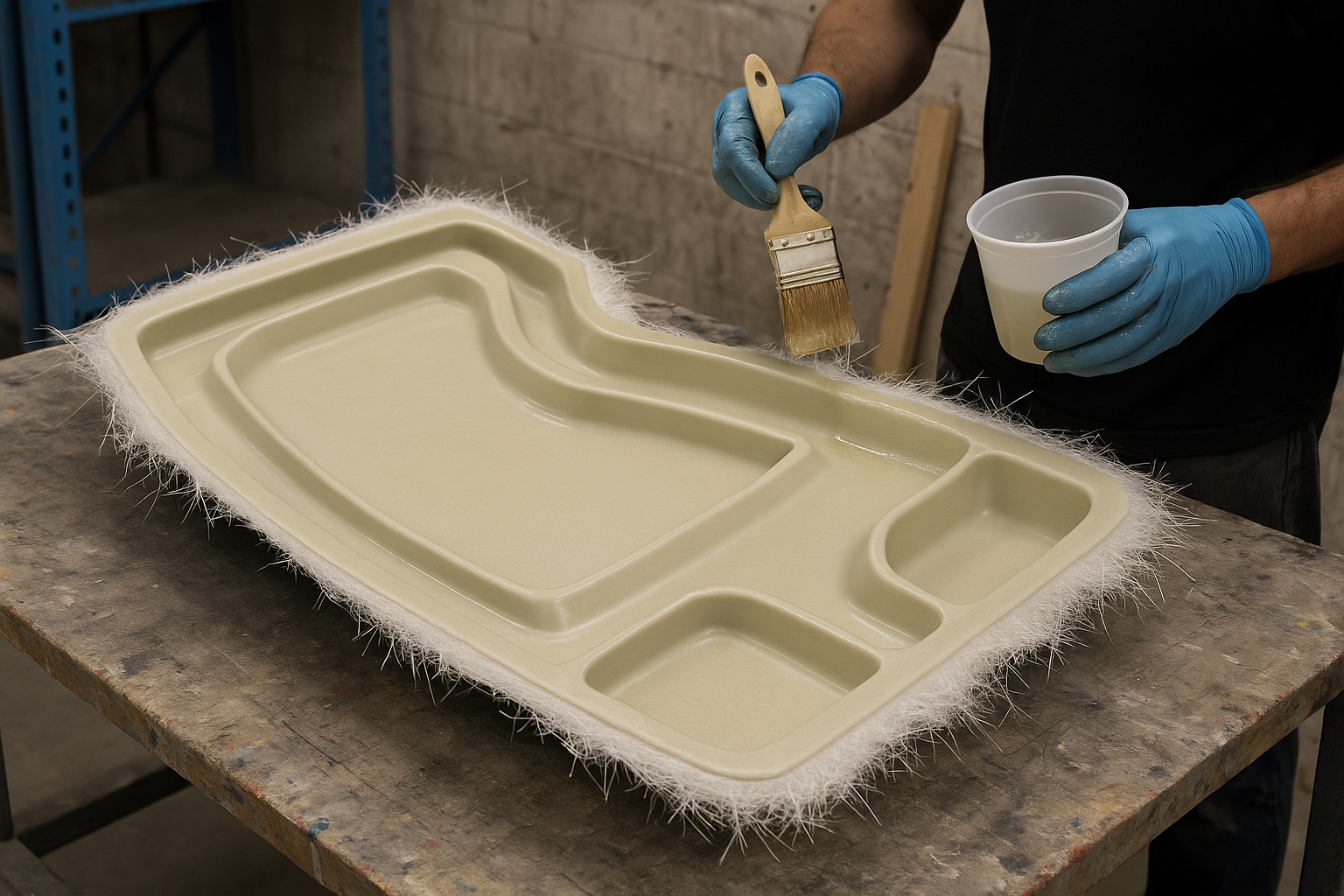Introduction
Industrial buyers juggling aggressive timelines and unforgiving environments need a manufacturing method that hits the sweet spot between strength, weight and lifetime value. Custom fiberglass molding delivers that balance—especially when you can lean on an ISO‑certified partner like Unicomposite, whose in‑house pultrusion, SMC/BMC and hand‑lay‑up lines give engineers design latitude without the drama of multi‑vendor coordination.

custom fiberglass molding
What Is Custom Fiberglass Molding?
Definition & Core Processes
Custom fiberglass molding is the engineered shaping of glass‑fiber reinforcement with thermoset resins into near‑net‑shape parts that match your drawings—a sharp contrast to cutting rectangles out of commodity sheet stock. Depending on geometry, tooling investment and target volumes, manufacturers choose among:
Pultrusion – continuous profiles with constant cross‑sections.
SMC/BMC compression – complex 3‑D surfaces in matched steel dies.
Hand lay‑up & vacuum infusion – low‑volume, large or highly specialized structures.
Typical Industries & Growth Data
Power‑grid cross‑arms, chemical plant grating, lightweight ladder rails, and drip‑free irrigation manifolds all share the same pain points: corrosion, conductivity, and downtime. That explains why the global Fiber Reinforced Polymer (FRP) composites market is forecast to expand at 6.5 % CAGR through 2030. Demand is rising fastest in Asia‑Pacific, but North‑American utilities remain strong adopters for their dielectric safety gains.
Is Custom Fiberglass Molding the Right Fit for Your Project?
Performance vs. Traditional Materials
| Property | Aluminum | Galvanized Steel | Molded FRP* | Benefit to You |
|---|---|---|---|---|
| Density (g/cm³) | 2.70 | 7.85 | 1.9 | Easier handling, lower freight |
| Tensile Strength (MPa) | 310 | 370 | 430 | Higher load with slimmer profiles |
| Corrosion Resistance | Fair | Good (needs coating) | Excellent | Zero repaint cycles |
| Dielectric Strength (kV/mm) | 15 | 0 | 18 | Safe near live conductors |
*Representative E‑glass / vinyl‑ester formulation.
Total Cost of Ownership & ROI
A five‑year maintenance model by a Mid‑Atlantic utility showed galvanized steel handrails required two full repaint cycles, adding $12/meter in labor and materials. Molded FRP handrails cost $6/meter more up front but eliminated coatings entirely, reaching break‑even after year 3 and saving $22,000 over 5 years on a 1,000‑meter run.
Critical Evaluation Factors Before You Commit
Design Complexity, Volume & Tooling Thresholds
Low volume (<200 pcs/yr): open mold or infusion; minimal tooling (<$2k).
Medium volume (200‑2,000): aluminum compression dies; balance cost vs. longevity.
High volume (>2,000): hardened steel pultrusion dies; tooling $20–40k but amortized quickly.
Compliance, Certifications & Environmental Conditions
Check ASTM D790 for flexural modulus, UL 94 for flame spread, EN 13706 for pultruded profiles, and IEEE 1138 when dielectric clearances matter. Confirm your supplier can provide lot traceability and third‑party resin cure verification to pass customer audits.
From Sketch to Shipment: The Engineering Workflow
Step‑by‑Step Process & Typical Timelines
Concept Review (Week 0‑1) – CAD exchange, laminate stack‑up, finite‑element preview.
Material Selection (Week 1‑2) – E‑glass vs. carbon, vinyl‑ester vs. epoxy, fire‑retardant fillers. Unicomposite keeps UL‑listed vinyl‑ester grades on the floor, trimming procurement time.
Tool Design & Fabrication (Week 2‑6) – In‑house CNC and EDM shorten lead‑times by ~20 %.
First‑Article Run (Week 7‑8) – Coupon testing: ASTM D638 tensile, D695 compressive, salt‑spray cycles.
Production & QC (Ongoing) – ISO 9001 audits, bar‑coded traceability, positive material identification.
Logistics (Weekly or Container Lot) – Sea‑container consolidation from Ningbo port or FOB local warehouse.
Quality Assurance
Every lot ships with a certificate of conformance, gel‑time curve, and infrared cure profile. Random tensile pulls are archived six years—longer than many contracts require—so you have data if field inspectors call.
Case Study: Resilient FRP Walkways for a Wastewater Plant
Challenge
Anaerobic digesters at a Midwest treatment facility were corroding galvanized grating in under three years, forcing weekend shutdowns for replacement.
Solution
The plant switched to custom‑molded FRP walkway panels featuring a 50 mm I‑beam core, grit topcoat, and grey fire‑retardant vinyl‑ester resin engineered by Unicomposite.
Outcome
“Our maintenance budget dropped 30 percent in the first year, and operators finally trust the walkways near open tanks,”
says the facility’s reliability manager.
After 24 months, visual inspections showed zero blistering or delamination, and skid resistance remained above OSHA’s 0.5 COF threshold.
Avoiding Common Pitfalls
Over‑specifying Resins & Fibers
Calling out aerospace‑grade carbon fiber for a parking shade fails the cost‑benefit test. Match resin/fiber to environment and mechanical loads—your supplier’s application engineers can run those calcs in hours, not days.
Ignoring UV, Fire, and Dielectric Requirements Early
Retro‑coating panels with intumescent paint or conductive braid after molding adds up to 18 % extra cost. Bake requirements into the spec sheet before tooling is cut.
Conclusion
Custom fiberglass molding outperforms legacy metals when weight, corrosion, or electrical isolation threaten uptime—and ROI math backs it up. Ready to validate your drawings? Contact our engineering desk for a no‑obligation design review or fast quote.
Frequently Asked Questions
Q1. How long does custom tooling take to build?
Most aluminum or steel tools require 4–6 weeks, including design approval and trial fit, though simple pultrusion dies can be expedited to 3 weeks.
Q2. Can I specify a color other than safety yellow?
Yes. Pigments are mixed directly into the resin, so any RAL or Pantone shade is feasible without affecting UV stability.
Q3. What tolerances are realistic for complex parts?
Pultruded profiles typically hold ±0.25 mm on critical dimensions; compression‑molded parts can reach ±0.15 mm with proper draft.
Q4. How is shipping damage prevented on long profiles?
Parts are bundled in heat‑sealed film, braced with MDF end‑caps, and loaded on A‑frames to avoid point loads during sea transit.
 info@unicomposite.com
info@unicomposite.com


























